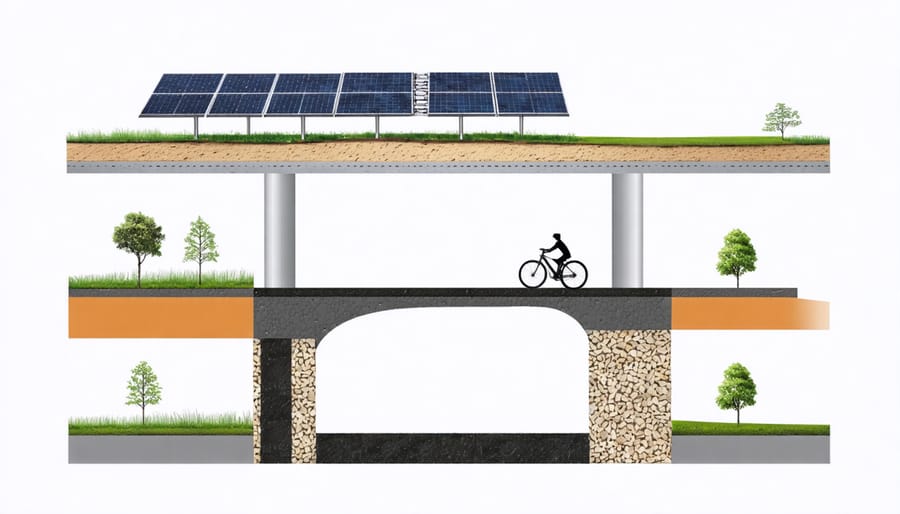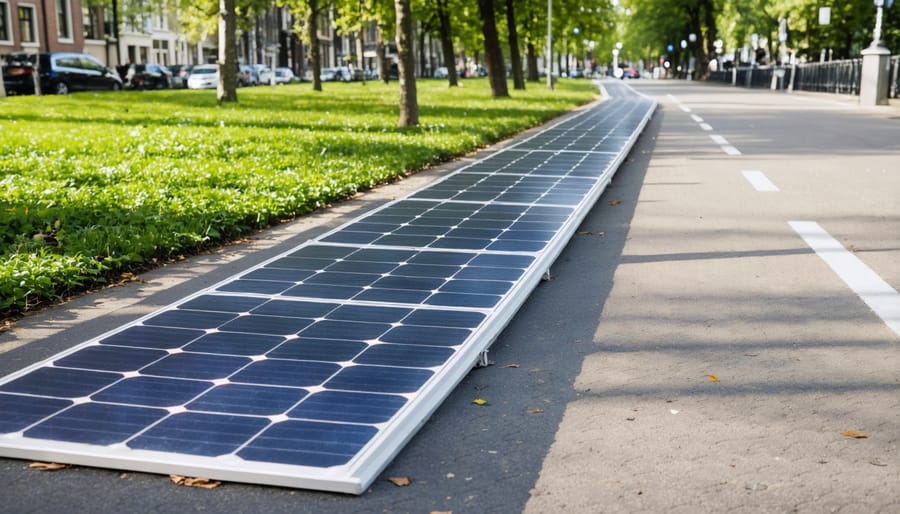Solar-Powered Bike Paths Transform European Urban Transport

Imagine a future where roads don’t just carry vehicles – they generate clean energy to power our cities. Solar-powered road technology is transforming European infrastructure, turning ordinary highways into sustainable power stations that harness the sun’s energy across thousands of kilometers of available surface area.
These innovative roadways integrate photovoltaic cells beneath transparent, ultra-durable surfaces, capturing solar energy while withstanding the weight and wear of daily traffic. Beyond simply generating electricity, these smart highways illuminate themselves at night, automatically melt snow and ice, and even charge electric vehicles as they drive.
From the Netherlands’ SolaRoad to France’s Wattway project, European nations are leading the global transition toward intelligent transportation infrastructure. Early pilot projects demonstrate that a single kilometer of solar highway can generate enough electricity to power 800 households, while reducing carbon emissions and creating a more resilient power grid.
As climate change demands bold solutions, solar highways represent a brilliant fusion of existing infrastructure with renewable energy technology – turning our vast road networks into clean power generators that work silently beneath our wheels.
The Technology Behind Solar Bike Paths
Specialized Solar Panel Design
Solar-powered highways require specially engineered panels that differ significantly from conventional rooftop installations. These innovative panels are designed to withstand constant foot and bicycle traffic while maximizing the solar energy potential in Europe through efficient energy harvesting.
The panels feature a unique three-layer construction: a high-strength tempered glass surface with anti-slip properties, an advanced photovoltaic cell array, and a robust protective base layer. The surface glass incorporates micro-texturing technology that enhances grip while maintaining optimal light transmission to the solar cells beneath.
Each panel measures 70cm x 70cm and is 6cm thick, capable of supporting loads up to 400 kg/cm². The integrated solar cells achieve a conversion efficiency of 15-18%, utilizing monocrystalline silicon technology adapted for varied light conditions. The panels are equipped with self-cleaning nano-coating that reduces maintenance requirements and maintains efficiency.
The design includes innovative water drainage channels that prevent puddle formation and facilitate surface runoff. LED indicators are embedded within the panels for pathway illumination and safety signaling. The modular construction allows for easy installation and replacement, while built-in sensors monitor performance and detect any maintenance needs. Connection points are weatherproofed to IP67 standards, ensuring reliable operation in all weather conditions.

Energy Storage Solutions
Energy storage is a critical component of solar-powered highways, ensuring continuous operation during periods of low sunlight and peak demand. Modern battery systems, particularly lithium-ion and advanced flow batteries, form the backbone of these innovative infrastructures, storing excess energy generated during daylight hours for nighttime use.
These storage solutions are strategically positioned along the highway infrastructure, typically housed in weatherproof containers that protect the sophisticated power management systems. Each storage unit is equipped with smart controllers that monitor energy flow, optimise distribution, and maintain stable power supply to all connected systems, from LED lighting to emergency services equipment.
The implementation of hybrid storage systems has proven particularly effective in European climate conditions. These systems combine short-term storage for immediate power needs with long-term storage solutions that maintain reserve power for extended periods of overcast weather. Advanced thermal management systems ensure optimal battery performance across varying temperatures, while intelligent load-balancing algorithms distribute power efficiently across the network.
Recent innovations in energy storage technology have significantly improved the cost-effectiveness of these systems. Modern batteries now offer higher energy density, longer operational lifespans, and reduced maintenance requirements. This advancement has made solar-powered highways increasingly viable for both urban and rural applications across Europe, supporting the continent’s transition towards sustainable transport infrastructure.
Smart Infrastructure Features
LED Lighting Systems
LED lighting systems integrated into solar-powered highways represent a significant advancement in road safety and energy efficiency. These self-sustaining illumination systems harness solar energy collected during daylight hours to power high-efficiency LED lights throughout the night, ensuring consistent visibility for all road users.
The lighting infrastructure typically consists of strategically placed LED arrays along road edges, medians, and critical points such as intersections and pedestrian crossings. Advanced sensors monitor ambient light levels and traffic conditions, automatically adjusting brightness to optimise energy consumption while maintaining safety standards.
Modern LED systems in solar highways can achieve up to 80% energy savings compared to traditional street lighting, while providing superior illumination quality. The lights are designed to withstand extreme weather conditions and require minimal maintenance, making them ideal for European climate conditions.
Some innovative implementations include dynamic lighting patterns that respond to traffic flow and weather conditions, as well as emergency response features that can create illuminated pathways for emergency vehicles. These smart lighting solutions contribute significantly to road safety while demonstrating the practical application of sustainable technology in modern infrastructure.

Weather Monitoring
Modern solar-powered highways incorporate sophisticated weather monitoring systems that enhance safety and maintenance efficiency. These integrated sensor networks continuously track crucial environmental parameters, including temperature, humidity, precipitation, and ice formation. The data collected helps authorities proactively manage path conditions and optimize energy distribution.
Smart sensors embedded within the solar road panels detect potentially hazardous weather conditions, such as black ice or standing water. This information triggers automated response systems, such as activating embedded heating elements or adjusting LED warning signals to alert path users of dangerous conditions ahead.
The monitoring system also plays a vital role in maintenance planning. By tracking surface wear, temperature fluctuations, and environmental stresses, maintenance teams can identify potential issues before they become serious problems. This predictive approach significantly reduces repair costs and extends the infrastructure’s lifespan.
Additionally, these sensors contribute to energy management by monitoring solar panel performance under various weather conditions, enabling optimal power distribution and storage strategies throughout the network.
Usage Analytics
Modern solar-powered highways incorporate sophisticated traffic monitoring and data collection systems that transform these routes into smart infrastructure networks. These integrated systems utilise sensors and monitoring equipment powered by the same solar energy that illuminates the roadway, creating a self-sustaining information ecosystem.
The analytics capabilities include real-time traffic flow monitoring, vehicle counting, and speed detection. Advanced sensors embedded within the solar road panels collect valuable data about traffic patterns, peak usage times, and vehicle weight distribution. This information helps transportation authorities optimise traffic management and plan maintenance schedules more effectively.
Weather monitoring stations along these solar highways provide crucial environmental data, including temperature, precipitation, and solar radiation levels. This information not only aids in road maintenance but also helps optimise the solar energy generation system’s performance.
The collected data supports predictive maintenance algorithms that can identify potential issues before they become problematic. For instance, the system can detect unusual stress patterns on specific road sections or variations in power generation efficiency that might indicate the need for maintenance.
Transportation authorities across Europe use this data to improve road safety, reduce congestion, and enhance overall infrastructure efficiency. The analytics platform also provides valuable insights for future solar highway projects, helping engineers and planners optimise design and implementation based on real-world performance data.
Environmental and Economic Benefits
Carbon Footprint Reduction
Solar-powered highways represent a significant leap forward in sustainable urban development, offering substantial environmental benefits through reduced carbon emissions. Studies indicate that implementing solar road technology across European highways could potentially reduce CO2 emissions by up to 50 million tonnes annually, equivalent to removing approximately 10 million cars from the roads.
The environmental impact extends beyond direct carbon reduction. Solar highways minimize land use conflicts by utilizing existing infrastructure, preserving natural habitats and agricultural areas. The integrated photovoltaic systems in road surfaces can generate clean energy while reducing the urban heat island effect, as these surfaces typically absorb less heat than conventional asphalt.
Analysis of pilot projects across Europe demonstrates that a single kilometer of solar highway can offset approximately 250 tonnes of CO2 emissions annually through clean energy generation. Additionally, the smart lighting systems powered by these installations reduce energy consumption by 30-40% compared to traditional street lighting.
The materials used in solar road construction are increasingly sustainable, with manufacturers incorporating recycled components and designing for end-of-life recyclability. This circular approach further reduces the overall environmental footprint of transportation infrastructure, setting new standards for green mobility solutions across the continent.
Long-term Cost Analysis
The financial implications of solar-powered highways extend far beyond initial installation costs, offering substantial long-term economic benefits. Initial investments typically range from €2-4 million per kilometre, depending on the scope and complexity of implementation. However, these costs are offset by multiple revenue streams and savings over the project lifecycle.
Energy generation from solar highways can yield significant returns through power sales to the grid or direct consumption by nearby facilities. A single kilometre of solar highway can generate approximately 1.5 GWh of electricity annually, translating to €150,000-200,000 in energy value per year at current European market rates.
Maintenance costs for solar highways are remarkably lower than conventional road infrastructure, primarily due to the protective nature of solar panels, which shield the road surface from weather-related wear and tear. This protection extends the road’s lifespan by 20-25%, reducing regular maintenance expenses by up to 30%.
The return on investment (ROI) typically materialises within 8-12 years, considering energy generation revenues, reduced maintenance costs, and potential government incentives. Furthermore, these installations create local employment opportunities and stimulate regional economic growth through increased industrial activity and tourism interest.
When factoring in environmental benefits and reduced carbon emissions, the social return on investment becomes even more compelling, making solar highways an economically viable solution for sustainable infrastructure development.

European Implementation Case Studies
The Netherlands has emerged as a pioneer in solar highway implementation, with the SolaRoad project in Noord-Holland serving as a remarkable success story. Launched in 2014, this 70-meter cycling path integrated solar panels beneath tempered glass, generating enough electricity to power three households. The project’s success led to its expansion in 2016, demonstrating the viability of solar highways in urban settings.
France has taken solar road technology to new heights with the Wattway project in Normandy. This one-kilometer stretch of solar pavement, installed in 2016, can power street lighting for a town of 3,400 residents. Despite initial challenges with durability, subsequent improvements in panel design and installation techniques have significantly enhanced performance and longevity.
Germany’s Solar Highway A81 near Stuttgart showcases how noise barriers along motorways can double as solar power generators. This innovative installation spans 2.7 kilometers and produces enough electricity to supply 650 households annually. The project exemplifies efficient land use by combining solar energy generation with essential infrastructure.
In Poland, the city of Rzeszów implemented a solar bike path using luminescent technology in 2019. This 100-meter track not only generates clean energy but also provides night-time illumination through stored solar power, enhancing cyclist safety and reducing municipal energy costs.
Belgium’s E40 highway project demonstrates large-scale solar integration along transport corridors. The installation of solar panels along a 2.5-kilometer stretch provides power to nearby communities and charging stations for electric vehicles, creating a sustainable transport ecosystem.
These successful implementations highlight Europe’s commitment to renewable energy innovation in transportation infrastructure. Each project has contributed valuable data on durability, efficiency, and integration techniques, paving the way for future developments across the continent. The lessons learned from these installations continue to inform new projects, driving improvements in technology and implementation strategies.
The future of solar-powered bike paths in Europe stands at a promising crossroads of innovation and sustainable urban development. With successful pilot projects like the SolaRoad in the Netherlands demonstrating both technical feasibility and practical benefits, these illuminated pathways are poised to transform European cycling infrastructure.
Current projections indicate that solar bike path installations could expand to cover up to 20% of suitable cycling routes across major European cities by 2030. This expansion would significantly contribute to the EU’s renewable energy targets while enhancing cycling safety and accessibility. The technology continues to evolve, with newer materials offering improved durability and energy conversion efficiency, making these installations increasingly cost-effective for municipalities.
Several European countries, including France, Germany, and Belgium, have already begun incorporating solar bike paths into their sustainable transport strategies. These initiatives are backed by growing public support and EU funding mechanisms dedicated to green infrastructure projects.
Looking ahead, the integration of smart technology with solar bike paths presents exciting possibilities. From real-time usage monitoring to adaptive lighting systems and even wireless charging capabilities for e-bikes, these innovations could revolutionize urban mobility. As installation costs decrease and efficiency improves, solar-powered bike paths are set to become a standard feature of sustainable European cities, offering a practical solution to both energy generation and safe cycling infrastructure needs.
Leave a Reply